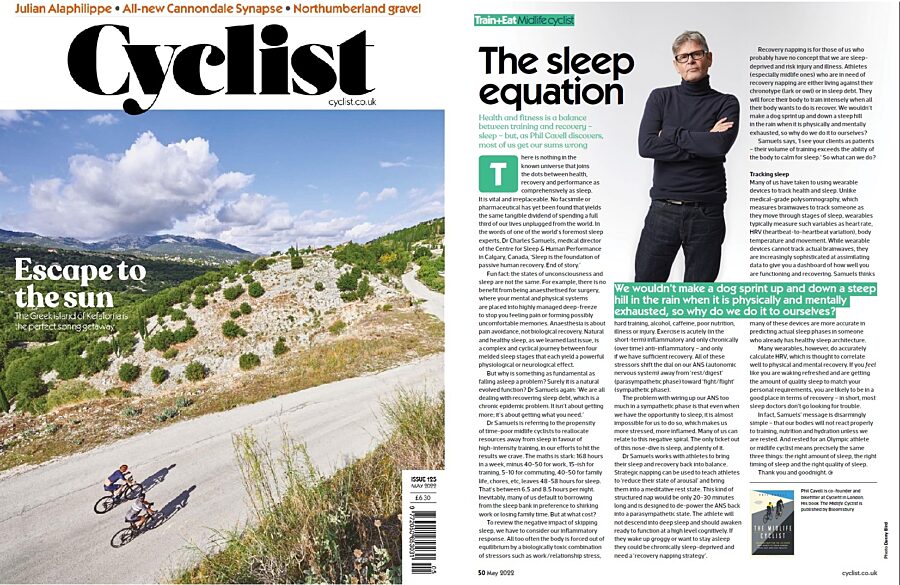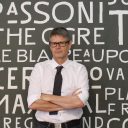
"Sleep is the foundation of passive human recovery. End of story"
The Sleep Equation
There is nothing in the known universe that joins the dots between health, recovery and performance as comprehensively as sleep.
It is vital and irreplaceable. No facsimile or pharmaceutical has yet been found that yields the same tangible dividend of spending a full
third of our lives unplugged from the world. In the words of one of the world’s foremost sleep experts, Dr Charles Samuels, medical director of the Centre for Sleep & Human Performance in Calgary, Canada, ‘Sleep is the foundation of passive human recovery. End of story.’
"Natural sleep is a complex and cyclical journey between four melded stages that each yield a powerful physiological or neurological effect"
Sleep by Numbers
Fun fact: the states of unconsciousness and sleep are not the same. For example, there is no recuperative benefit from being anaesthetised for surgery, where your mental and physical systems are placed into highly managed deep-freeze to stop you feeling pain or forming possibly uncomfortable memories. Anaesthesia is about pain avoidance, not biological recovery. Natural
and healthy sleep, as we learned last issue, is a complex and cyclical journey between four melded sleep stages that each yield a powerful physiological or neurological effect.
But why is something as fundamental as falling asleep a problem? Surely it is a natural
evolved function? Dr Samuels again: ‘We are all dealing with recovering sleep debt, which is a chronic epidemic problem. It isn’t about getting more; it’s about getting what you need.’ Dr Samuels is referring to the propensity of time-poor midlife cyclists to reallocate
resources away from sleep in favour of high-intensity training, in our efforts to hit the results we crave. The maths is stark: 168 hours in a week, minus 40-50 for work, 15-ish for training, 5-10 for commuting, 40-50 for family life, chores, etc, leaves exactly 48-58 hours for sleep. That’s between 6.5 and 8.5 hours per night.
Inevitably, many of us default to borrowing from the sleep bank in preference to shirking work or losing family time. But at what cost?
"Exercise is acutely inflammatory and only chronically anti-inflammatory"
The Inflammation Response
To review the negative impact of skipping sleep, we have to consider our inflammatory response. All too often the body is forced out of
equilibrium by a biologically toxic combination of stressors such as work/relationship stress, hard training, alcohol, caffeine, poor nutrition, illness or injury.
Exercise is acutely (in the short-term) inflammatory and only chronically (over time) anti-inflammatory – and only if we have sufficient recovery.
All of these stressors shift the dial on our ANS (autonomic
nervous system) away from ‘rest/digest’ (parasympathetic phase) toward ‘fight/flight’ (sympathetic phase).
The problem with wiring up our ANS too much in a sympathetic phase is that even when we have the opportunity to sleep, it is almost impossible for us to do so, which makes us more stressed, more inflamed. Many of us can relate to this negative spiral. The only ticket out of this nose-dive is sleep, and plenty of it.
Dr Samuels works with athletes to bring their sleep and recovery back into balance. Strategic napping can be used to teach athletes
to ‘reduce their state of arousal’ and bring them into a meditative rest state. This kind of structured nap would be only 20-30 minutes
long and is designed to de-power the ANS back into a parasympathetic state. The athlete will not descend into deep sleep and should awaken ready to function at a high level cognitively. If
they wake up groggy or want to stay asleep they could be chronically sleep-deprived and need a ‘recovery napping strategy
"You wouldn’t make a dog sprint up and down a steep hill in the rain when it is physically and mentally exhausted, so why do we do it to ourselves?"
The Sleep v's Success Model
Recovery napping is for those of us who probably have no concept that we are sleep deprived and risk injury and illness. Athletes (especially midlife ones) who are in need of recovery napping are either living against their chronotype (lark or owl) or are in sleep debt. They will force their body to train intensely when all their body wants to do is recover. We wouldn’t make a dog sprint up and down a steep hill in the rain when it is physically and mentally exhausted, so why do we do it to ourselves?
Samuels says, ‘I see your clients as patients – their volume of training exceeds the ability of the body to calm for sleep.’ So what can we do?
"I see your clients as patients – their volume of training exceeds the ability of the body to calm for sleep"
Tracking Sleep
Many of us have taken to using wearable devices to track health and sleep. Unlike medical-grade polysomnography, which measures brainwaves to track someone as they move through stages of sleep, wearables typically measure such variables as heart rate,
HRV (heartbeat-to-heartbeat variation), body temperature and movement.
While wearable devices cannot track actual brainwaves, they are increasingly sophisticated at assimilating data to give you a dashboard of how well you are functioning and recovering. Samuels thinks many of these devices are more accurate in
predicting actual sleep phases in someone who already has healthy sleep architecture. Many wearables, however, do accurately
calculate HRV, which is thought to correlate well to physical and mental recovery. If you feel like you are waking refreshed and are getting the amount of quality sleep to match your personal requirements, you are likely to be in a good place in terms of recovery – in short, most sleep doctors don’t go looking for trouble.
In fact, Samuels’ message is disarmingly simple – that our bodies will not react properly to training, nutrition and hydration unless we are rested. And rested for an Olympic athlete or midlife cyclist means precisely the same three things:
- The right amount of sleep
- The right timing of sleep
- And the right quality of sleep.
Thank you. And goodnight
Phil Cavell is co-founder and bikefitter at Cyclefit in London. His book The Midlife Cyclist is published by Bloomsbury
This Column was first published in Cyclist Magazine - May 2022 and is re-printed here with their kind permission.

